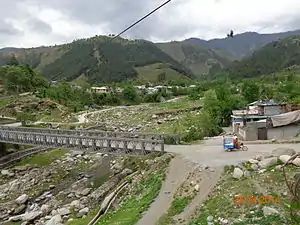Shah Ismail Dehlvi
Shah Ismael (26 April 1779 – 6 May 1831) was an Indian Sunni Hanafi Maturidi[1][2] Islamic Scholar and an active member in the jihad proclaimed by Syed Ahmad Barelvi with the support of Pushtun tribes against the Sikh Empire, which ruled the northwest Indian subcontinent with their base in Punjab in the early half of the 19th century.[3][4]
Shah Ismail Shaheed | |
|---|---|
| Born | 26 April 1779 |
| Died | 6 May 1831 (aged 52) |
| Known for | Battle of Balakot in 1831 |
Notable work | Taqwiyatul Imaan |
| Relatives | Shah Waliullah (grand-father) |
Early life and career
Dehlvi was born on 26 April 1779.[4] He was the grandson of famous Islamic scholar and leader Shah Waliullah Dehlawi, through his son Shah Abdul Ghani.[4] When a new Islamic religious revivalist movement appeared in northern India under the leadership of Syed Ahmad Barelvi (1786 – 1831), he was joined by two members of the Shah Waliullah family: Shah Ismail Dehlavi (1771-1831) and Maulvi Abdul Hai (died 1828)[5] who joined it because they shared its mission and objectives. "The agenda of the new movement known as Tariqah-i-Muhammadiyah was to purify the tenets of Islam from Hindu customs, traditions and cultural practices."[6] "His motive was to convince the Muslim community to purify Islam from Hindu influences and Shiite rituals. He was harsh in his criticism and believed that religion should be practiced in its original form; a thought process which gradually evolved into a Jihad movement."[6] Barbara Metcalf writes:
"Sayyid Ahmad's reformist teachings were set down in two works that, when printed on the new lithographic press of the day, soon achieved wide circulation. The Sirat'ul Mustaqim (the Straight Path) was compiled by Muhammad Ismail in 1819. Written initially in Persian, it was translated into Urdu in order to reach a wider audience. The second work, Taqwiyatul-Iman or the strengthening of the Faith, was written directly in Urdu. The two works stressed above all the centrality of tawhid, the transcendent unity of God, and denounced all those practices and beliefs that were held in any way to compromise that most fundamental of Islamic tenets. God alone was held to be omniscient and omnipotent. He alone, entitled to worship and homage. There were, the followers of Sayyid Ahmad argued, three sources of threat to this belief: false sufism, Shiá doctrines and practices, and popular custom".[7]
According to Andreas Rieck, Syed Ahmad visited towns of North Indian planes from 1818 to 1821 with hundreds of missionaries to preach against Shia beliefs and practices. Syed Ahmad repeatedly destroyed ta'ziyas, an act that resulted in subsequent riots and chaos.[8] Barbara Metcalf offers the following explanation to his anti-shi'ism:
"A second group of Abuses Syed Ahmad held were those that originated from Shi’i influence. He particularly urged Muslims to give up the keeping of ta’ziyahs. The replicas of the tombs of the martyrs of Karbala taken in procession during the mourning ceremony of Muharram. Muhammad Isma’il wrote, ‘a true believer should regard the breaking a tazia by force to be as virtuous an action as destroying idols. If he cannot break them himself, let him order others to do so. If this even be out of his power, let him at least detest and abhor them with his whole heart and soul’. Sayyid Ahmad himself is said, no doubt with considerable exaggeration, to have torn down thousands of imambaras, the building that house the taziyahs".[9]
In 1821, Shah Ismail left for Hajj along with Syed Ahmad and a group of his devotees. He returned from Haj in 1823, and once again visited different parts of India. For Syed Ahmad and the followers of the Faraizi movement, India was “Darul Harb” the capital of war and therefore jihad was obligatory for the Muslims. In his book, Sirat-e-Mustaqeem, Shah Ismail Dehlavi wrote:
“a large part of present-day India has become “Dar-ul-Harab”. Compare the situation with the heavenly blessings of India two and three hundred years ago”.[5]
Comparing India with Darul Islam, he said:
“compare India with Rome and Turkey in terms of heavenly blessings”.[5]
Establishment of Islamic State
The objectives of this movement was to establish an Islamic state where the Muslim community could observe pure teachings of Islam. At that time, much of North India was ruled by the British. So this movement leadership concluded that they should move to an area with less control of the British and with large majority of Muslim population – North-West Frontier region which is now called Khyber Pakhtunkhwa in Pakistan. "Khyber Pakhtunkhwa region was chosen to carry out this experimentation, based on the assumption that being devout Muslims, the Pakhtuns would support the reformist movement.".[10]
When the action began, some Muslim nawabs, like Amir Khan of Tonk, provided funds but did not join them for jihad. Around 8,000 holy-warriors who accompanied them were mostly clergymen or poor people who joined the militia were looking for employment. The rulers of Tonk, Gwalior and Rampur supported him with British consent because they were dependent on British forces and they knew well enough that the British would not stop them from aiding an enemy of the Sikhs. Since Syed Ahmad’s campaign was based on Islamic concept of jihad, his spokesman, Shah Ismail Dehlavi, tries to create desire for the war by saying:
“as far as the special (sexual) benefits are concerned that go to the faithful Martyrs, the Muslim Mujahideen, the ruling Sultans and the brave men of the battle field, don’t need to be elaborated here”.[5]
Arriving in Peshawar valley in late 1826, Sayyid Ahmad and his followers made their base in towns of Hund and Zaida in Swabi District[11] Dehlavi and Syed Ahmad preached jihad amongst the local Pashtun tribes, demanding they renounce their tribal customs and adopt the Shariah. The traditional khan were replaced by ulama (clerics) and a system of Islamic taxes was established to finance the jihad. Only after this evangelist campaign and sharia system was had set up was jihad declared. He sent a message to Ranjit Singh to
“either become a Muslim, pay Jizyah or fight and remember that in case of war, Yaghistan supports the Indians”.[5]
The mujahideen received both ideological preaching and physical training sessions. Syed Ahmad and Ismail Dehlavi organized wrestling, archery training and shooting competitions. The mujahideen also sang anthems. One such anthems has survived, known as "Risala Jihad", it goes as follows:
"War against the Infidel is incumbent on all Musalmans;
make provisions for all things.
He who from his heart gives one farthing to the cause,
shall hereafter receive seven hundred fold from God.
He who shall equip a warrior in this cause of God,
shall hereafter obtain a martyr's reward;
His children dread not the trouble of the grave,
nor the last trump, not the Day of Judgement.
Cease to be crowds; join the divine leader, and smite the Infidel.
I give thanks to God that a great leader has been born,
in the thirteenth of the Hijra".[12]
In December 1826 they clashed with Sikh troops at Akora with some success. On 11 January 1827, allegiance was sworn on his hand and Syed Ahmad was declared Caliph and Imam. Syed Ahmad’s claim of leadership (Caliphate) was viewed with suspicion in the Frontier region as well as in the clerical circles of North India. When the Friday sermon was read in his name, it became clear to the tribal chiefs that he wanted the political power for himself. According to Khadi Khan, a Pathan sardar:
“it is the job of the Sardars to take care of the people, not a Maulvi who spends his life on donations. Maulvies are ill-equipped to run the affairs of a State”.[5]
Syed Ahmad tried to explain that his aim was not this-worldly but to lead jihad against the infidels. In one of his letters, he writes:
“We thank and praise God, the real master and the true king, who bestowed upon his humble, recluse and helpless servant the title of Caliphate, first through occult gestures and revelations, in which there is no room for doubt, and then by guiding the hearts of the believers towards me. This way God appointed me as the Imam (leader)”.[5]
Criticizing the opponents, Shah Ismail Dehlavi wrote:
“therefore, obedience to Syed Ahmad is obligatory on all Muslims. Whoever does not accept the leadership of His Excellency or rejects it after accepting it, is an apostate and mischievous, and killing him is part of the jihad as is the killing of the disbelievers. Therefore, the appropriate response to opponents is that of the sword and not the pen”.[5]
Regarding his Imamate, Syed Ahmad wrote to Nawab Wazir ud-Dawla, the ruler of Tonk:
“believe me, the person who sincerely confesses to my position is special in the eyes of God, and the one who denies it is, of course sinful. My opponents who deny me of this position will be humiliated and disgraced”.[5]
Mubarak Ali writes:
"After the conquest of Peshawar, Syed Ahmad launched a violent policy to enforce Shari’ah and announced the abolition of all tribal rituals that he considered illegal. The most important of these rituals were: the bride was paid a regular price for marriage, the wives of the deceased were divided among his heirs, more than four marriages were practiced, women could not inherit property, internecine wars were considered jihad and plunder was considered booty. Therefore, after the conquest of Peshawar, orders were issued that those who can give half of the agreed money to the brides can take them. The young girls (9 year old and above) who are eligible for marriage should be married immediately. To enforce Shari’ah law, he appointed Imam Qutbuddin as an ombudsman, accompanied by 30 armed soldiers, who accompanied him to nearby villages to beat up the people who had abandoned prayers. Beatings and flogging had become the norm, that if the ombudsman went to any village, panic would spread. Punishment was carried out with extreme violence and people were even hanged on tree branches. Even among women, those who missed prayers were punished in the women’s quarters, so people soon became fed up with these polices because these judges and ombudsmen started harassing people and imposed fines on them beyond their means".[5]
In addition to the stated social agenda, Sayyid Ahmad also attempted to collect the Islamic tithe (usher) of ten per cent of crop yields. The alliance was defeated and the Islamic reformers finally occupied Peshawar. Over several months during 1830 Sayyed Ahmad tried to conciliate established power hierarchies. But before the end of 1830 an organized uprising occurred and the agents of Sayyid Ahmad in Peshawar and in the villages of the plain were murdered and the movement retreated to hills.
They ran into trouble in this area with many of these Pakhtun tribes because they had no cultural or linguistic relation to the locals and tried to wipe out their own old tribal rules and customs by force. Some of their old tribal leaders had sensed a threat to their own prevailing influence over the local tribal population and their traditional Pakhtun nationalism which they were not willing to give up and hand their power and influence over to the newcomers in their area in the name of Islam.[10]
Punjab, parts of North-West Frontier and Kashmir regions, in 1831, were under the strict rule of powerful Maharaja Ranjit Singh who also had future ambitions to control all of the North-West Frontier region of the Pashtuns. So he sent his powerful Sikh army to fight them and after a fierce battle, defeated them, at Balakot. There in the town of Balakot in 1831, Syed Ahmad was killed by the Sikh Army. He was beheaded.[11][13]

.
Death and legacy
Ismail Dehlvi was killed on 6 May 1831 during a fierce battle at Balakot against the army of Maharaja Ranjit Singh (1780 – 1839), the ruler of the region at that time.[3] "Traditional historians accused the Pakhtun tribes of betraying the religious cause and glorified the role of the movement."[10] Some other historians point out that the British government silently supported the movement and its planned migration to the North-West Frontier region. "Most probably, the British government wanted to shift the troublesome elements from the territory under their control to that of the Sikhs' in order to weaken the Sikh rule."[6][4]
Literary works
Gallery
- Gravesite of Dehlvi's Tomb
_%252C_Balakot.jpg.webp) Grave of Dehlvi, Balakot, Khyber Pakhtunkhwa, Pakistan
Grave of Dehlvi, Balakot, Khyber Pakhtunkhwa, Pakistan Grave of Dehlvi as seen from ground level
Grave of Dehlvi as seen from ground level Grave of Dehlvi seen from the place he got martyrdom
Grave of Dehlvi seen from the place he got martyrdom The battle place of Balakot over Satbane Fountain
The battle place of Balakot over Satbane Fountain
References
- Dehlvi, Shah Ismail. Yuk Roza. Faruqi Kutubhana. p. 2.
- Sindhi, Ubaidullah (1976). At-Tamheed li Ta'reef Aimma at-Tajdeed. The Sindhi Adabi Board. p. 286.
- Profile of Sikh ruler Ranjit Singh on Encyclopedia Britannica Retrieved 16 August 2018
- Profile of Dehlvi on books.google.com website Retrieved 16 August 2018
- Dr. Mubarak Ali, “Almiyah-e-Tarikh”, Chapter 11, pp.107-121, Fiction House, Lahore (2012).
- Past present: When history fails Dawn (newspaper), Published 3 March 2012, Retrieved 16 August 2018
- B. Metcalf, "Islamic revival in British India: Deoband, 1860–1900", pp. 56 - 57, Princeton University Press (1982).
- Andreas Rieck, "The Shia's of Pakistan", p. 16, Oxford University Press (2016).
- B. Metcalf, "Islamic revival in British India: Deoband, 1860–1900", p. 58, Princeton University Press (1982).
- Past present: The intolerant invaders Dawn (newspaper), Published 12 June 2013, Retrieved 16 August 2018
- Wahhabi movement in India. Qeyamuddin Ahmad, (1994, p.50). open library
- Charles Allen, "God's Terrorists: The Wahhabi Cult and the Hidden Roots of Modern Jihad", p. 86, Abacus (2006).
- Qeyamuddin Ahmad, Wahhabi movement in India, (1994, p.55)
External links
- Syed Ahmed Barelvi and his Jihad movement
- eBook in Urdu language on Shah Ismail Shaheed with introduction by Abu Ala Maududi, Published 1 October 1943 by Qaumi Kutub Khana, Lahore
- Taqwiyat-ul-Iman (Strengthening of the Faith) an eBook translated in English and originally written by Shah Ismail Dehlvi on islamhouse.com website
